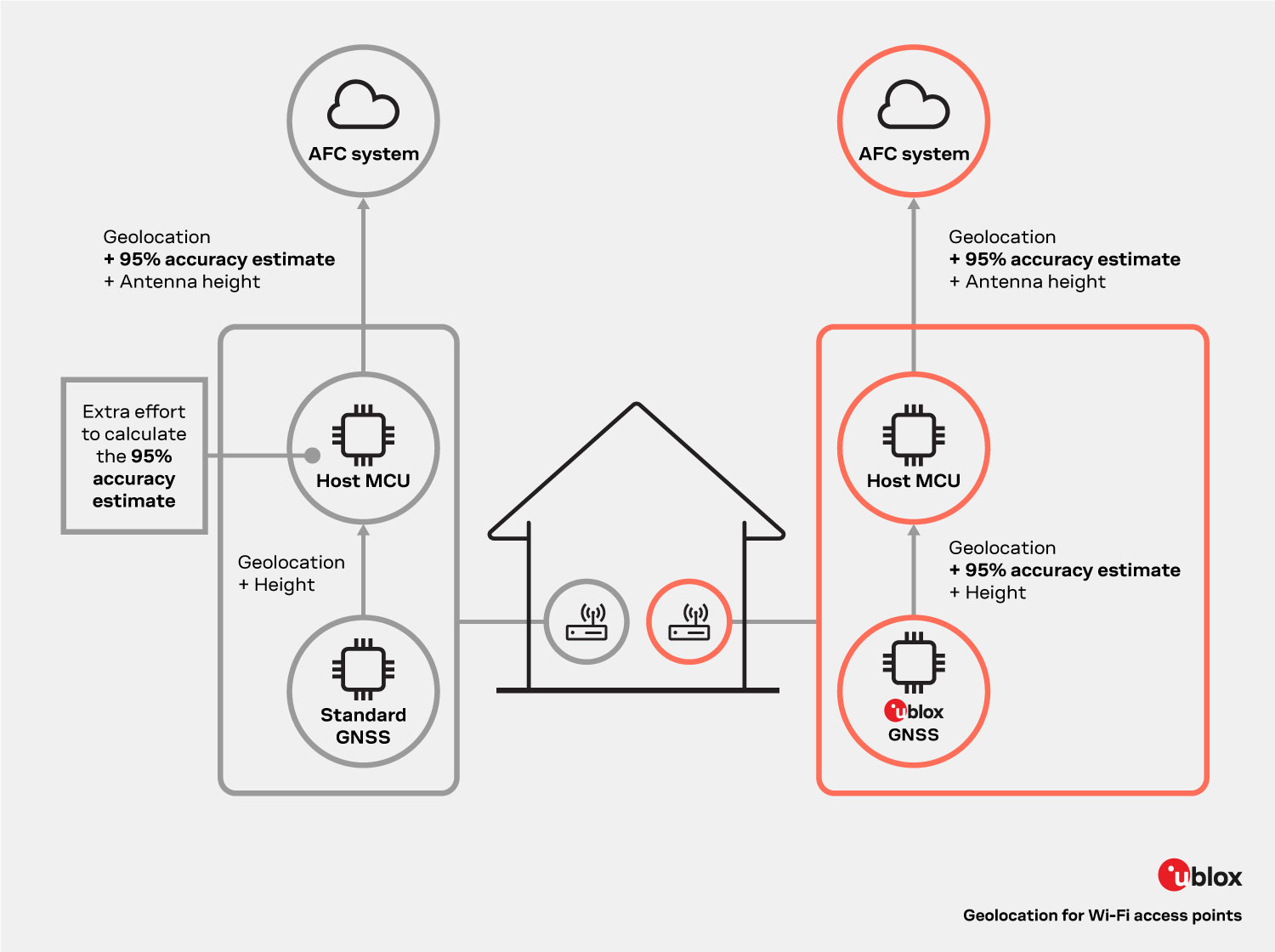.jpg)
- Support portal
- Evaluation Kits and partner products
u-blox Support
- Product documentation
Documentation
- Investor relations
Investor relations
Tech
|
22 Dec 2022
The world’s relentless demand for connectivity and hunger for bandwidth and throughput is driving a continuous cycle of innovation in wireless technologies.

Wi-Fi 6E, launched in 2021, gains enormous benefits from access to increased spectrum, enabled by the FCC’s decision to open the 6 GHz band to unlicensed use. Even as the market gears up to deliver a new generation of Wi-Fi 6E devices, expectations are already building for the next generation of Wi-Fi technology, Wi-Fi 7, with its promise of data rates up to 46 Gbps.
Throughout its various generations, Wi-Fi has co-existed with licensed users of spectrum and, to ensure that this remains the case in the 6 GHz band, the FCC have introduced regulations to which manufacturers of Wireless Access Points, (APs), must comply. Manufacturers of Standard Power APs, defined as transmitting up to 4W EIRP, must ensure that their devices can accurately share their geolocations via a recognized Automated Frequency Coordination, (AFC), service. This requirement presents several challenges, particularly where the AP is destined for an indoor location and unable to obtain a GNSS (Global Navigation Satellite System) fix.
In this blog post we describe how u-blox have leveraged their expertise in the automotive industry to develop the u-blox M10 ultra-low power GNSS platform, a highly accurate integrated positioning solution. With its protection level feature fulfilling the 95% confidence level on position accuracy mandated by the FCC, the u-blox M10 platform is the ideal choice for the Wi-Fi 6E designer who needs to reduce time to market with a cost-optimized AP.
The wireless industry has moved rapidly since the FCC’s 2020 decision to open the 6 GHz band. The Wi-Fi Alliance, which had been developing the Wi-Fi 6E specifications in anticipation of the FCC announcement, was quick to launch its Wi-Fi 6E certification program, boosting the global momentum of the Wi-Fi 6E roll-out. At the beginning of September 2022, Japan became the latest of over twenty-two countries to adopt the operation of Wi-Fi 6E systems in the 6GHz band, with many more currently planning to do so. A growing number of manufacturers are equipping their smart devices, including laptops, smartphones, and TVs with Wi-Fi 6E and the Wi-Fi Alliance projects that global sales of Wi-Fi 6E devices will exceed 350 million in 2022.
While this is good news for the user, unlicensed use of 6 GHz spectrum comes with restrictions which access point developers must understand. To safeguard services provided by incumbent, licensed, users of the band, the FCC in the United States has defined three main classifications for AP devices, based on transmit power levels – and hence their potential to interfere with incumbents:
Out of the above three categories, Standard Power Access Points risk interfering with incumbent 6 GHz links, therefore some form of spectrum coordination system is required to protect them from new, unlicensed (Wi-Fi) systems.
The FCC has mandated the use of an approved Automated Frequency Coordination, (AFC), service for Standard Power APs. Known by different names according to the frequency band, AFC systems all share the same core functionality, which is to:
During operation the AP is required to interact with the AFC by:
The importance of 6 GHz Standard Power is driving significant regulatory activity around the world. In the United States, for example, the FCC received proposals from 14 AFC operators in response to its recent solicitation. Elsewhere Canada, Korea and Saudi Arabia have firm plans to adopt AFC systems, while other countries, including the European Union and Brazil are currently investigating such systems.
As discussed above, to operate with an AFC system, a Standard Power Wi-Fi 6E AP must be able to self-determine its position, a requirement which can present multiple challenges to the AP developer. Many APs will be unable to obtain a GNSS signal due to challenging signal locations or multi-path reflections. Various techniques can be deployed to overcome these limitations; GNSS data can be fused with other localization methods, including Wi-Fi Fine Time Measurement, Ultra-Wideband (UWB), Bluetooth 5.1 Angle of Arrival, and proprietary RF Time of Flight. Access points mounted close to windows or outdoors can be used as “anchors”, where the remaining indoor APs on site can be localized using a combination of these other methods.
Whatever approach is chosen, appropriate algorithms must be used to determine location accuracy to the 95% confidence level required by the FCC. This level of complexity can require additional skillsets and development time – and cost – with consequent impacts on project budgets and timescales.
The M10 is u-blox’s tenth generation GNSS technology platform, integrating two decades of experience based on more than half a billion sales of GNSS receivers. Fitting into a four-by-four-millimeter QFN package, and consuming less than 15 mW of power in continuous tracking mode, the device is suited to a wide range of industrial and consumer use cases.
.jpg)
Figure 1: The u-blox M10 platform offers different chip and module form factors
Concurrent reception of four GNSS constellations ensures maximum positioning availability – and consequently highly reliable positioning accuracy – and the M10’s high RF sensitivity drastically reduces the time required to establish a position fix. The platform also features advanced jamming, spoofing, and RF interference mitigation, and accuracy is further enhanced by u-blox Super-S technology, which boosts performance in weak signal environments or when used with small antennas, delivering up to 25 percent improvement in position accuracy for no-line of sight antenna placements. It offers a stationary mode and APs using the M10 are able to meet the FCC’s 95% confidence level on positioning accuracy using the protection level feature, figure 2, which continuously calculates the upper bound of the GNSS receiver’s expected error, based on all commonly occurring error sources.

Figure 2: The Protection Level feature of the M10 continuously calculates the upper bound of the receiver’s expected error
Adding the u-blox AssistNow service improves the u-blox M10 GNSS acquisition performance in challenging indoor environments for an even quicker and more accurate first reported position.
Worldwide adoption of Wi-Fi 6E is rapidly increasing and according to ABI research, global shipments of Wi-Fi 6E access points will rise from 1.5 million in 2022 to 5.2 million in 2024. The u-blox M10 offers the developer a quick, low power solution to the uncertainty reporting requirements of the Standard-Power AP, with meter-level accuracy solution in a small form factor. The M10 chip and associated modules and development kits simply the design of the GNSS functionality, reducing development cycles and accelerating time to market.
To learn more about our u-blox M10 GNSS technology platform, head over to the u-blox M10 product page or contact your nearest sales representative.
Bernd Heidtmann
Product Manager, Product Strategy for Standard Precision GNSS, u-blox
Nabeel Khan
Regional Application Marketing Manager, Americas, u-blox